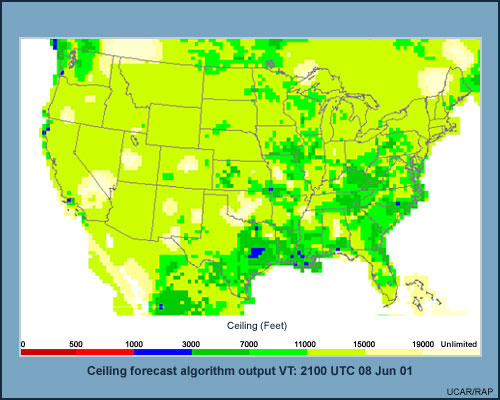RAP Ceiling and Visibility Forecast Algorithm
(last updated 8/3/2005)
Overview
Studies indicate that numerical models may be able to provide valuable information that can be translated into improved short-term ceiling and visibility predictions. Although advances in numerical modeling have been substantial over the past few decades, considerable research and development is still needed for these models to more accurately resolve clouds and precipitation.
In order to improve ceiling and visibility forecasts, the University Corporation for Atmospheric Research's Research Applications Program (RAP) is using an integrated data approach to try to improve improve ceiling and visibility analyses and short-term forecasts. The experimental algorithm developed by RAP uses data from pilot reports (PIREPS), radar, satellites, surface observations, and numerical model fields.
The products are strictly experimental as of this writing and should not be used to make direct forecast decisions. Verification of its performance is not complete. However, in the future it may become a viable addition to the forecaster's toolkit to assist in ceiling and visibility forecast development. The real-time product and more detailed explanations are found at the RAP Ceiling and Visibility Website.
Regional Applications
Currently, the scheme produces graphical products for the continental U.S. (CONUS) and southern California (SOCAL). The CONUS and SOCAL product domains are shown in the graphics. Six-hour forecasts for ceiling and visibility are provided for each domain. Additionally, Java-based products are available and include the ability to overlay VORs, TAFs, and METARs.

Limitations
Any forecast model, technique or algorithm is only as good as the data it has to work with. For the C/V algorithm the following limitations apply:
- In many cases, the information required to make quality forecasts of C/V is not available on the spatial and temporal scales necessary to accurately assess the initial conditions
- A complete understanding of the physical processes associated with fog and low stratus has not been achieved
- Considerable research and development is necessary to reach a state where numerical models can more accurately resolve clouds and precipitation.
Advantages
In an attempt to combat the above limitations, the C/V algorithm
- Integrates various data and forecasting techniques that are proven to have skill in the analysis and short-term forecasting of C/V
- Uses data and rules in adaptive weighting and data fusion techniques in an attempt to replicate the reasoning process of the human forecaster through objective approaches
- Is tested operationally by forecasters who subjectively examine data and use established "rules of thumb" to reach conclusions about future C/V
Status
The present version of the national ceiling and visibility expert system was developed through joint funding from the FAA, NASA and the Navy. Development of the ceiling and visibility expert forecast system is under a seven-year development plan. As of this writing, future plans include:
- Further development of the expert algorithm, focusing on incorporating advances in numerical models, expanding the use of satellite data, integrating emerging scientific developments/techniques, and using independent verification feedback to further improve the overall quality of the product
- Incorporating the next generation RUC (20 km) initial condition improvements, increased spatial resolution, and improvements in QPF
- Development of improved surface characterization, better representation of local advections, better droplet size distribution characterization, and data assimilation
- An emphasis on producing a sound CONUS system that displays good performance before attempting to develop an Alaska system
- The use of confidence levels for the end-user product display
- Development of a next-generation translation algorithm and observation-based statistical ceiling and visibility (C/V) forecast equations
There are no set plans at this time to transition this product from research operations.